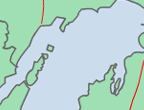General Approach
In this section, you will learn about the mathematical equations behind the tourism traffic models.
The regression analysis revealed that the best measure of tourism traffic on selected Michigan roadways on a daily basis was: “traffic (the dependent variable) is determined to be a function of the amount of daily precipitation, the daily recorded high temperature, the monthly Midwestern region Consumer Confidence Index (CCI)—as defined by The Conference Board, whether the day is a holiday, whether the day falls on a weekend, and in which year the day occurs (the independent variables).”
Conceptually, this equation is expressed as: Traffic = f(precipitation, maximum temperature, CCI, holiday, weekends, year).
Variables that were tested in the model but were found to be statistically insignificant or collinear (which occurs when two variables are highly correlated and both convey essentially the same information), and were thusly disregarded, included: monthly statewide unemployment rates, monthly Great Lakes water levels, daily historical heat index values, annual auto ownership costs, and surprisingly—gasoline prices. It remains to be seen whether the recent, dramatic rise in gasoline prices will make this variable statistically significant in versions of the model containing more recent data.
Upon further examination, the researchers decided that the model would provide more accurate output if it was split into four seasonal models to account for climatic and other changes across the years. The seasons were defined as:
Spring = March, April, May;
Summer = June, July, August;
Fall = September, October, November; and
Winter = December, January, February.
The two weather variables that were used in the model include:
Temp = The daily recorded high temperature; and
Precip = The daily recorded precipitation total, including all types.
The economic variable included in the model is the monthly Midwest region Consumer Confidence Index, as reported by The Conference Board. Since past research has proven that the vast majority of tourists in Michigan originate from this region, this variable was deemed to be a better measure than the national Consumer Confidence Index for this application. This variable was defined as:
CCI = Monthly Midwest region Consumer Confidence Index.
Several dummy variables were also developed to allow for the consideration of whether individual days occurred during holiday periods known to impact tourism traffic. Those variables include:
Wk1 = A Friday or Sunday of a non holiday-associated weekend;
Wk2 = A Saturday of a non holiday-associated weekend;
Hdy1 = A single-day holiday that falls on Tuesday, Wednesday, or Thursday
(i.e., July 4thon a Wednesday);
Hdy2 = The day prior to, or the last day of, a holiday-weekend period
(i.e., A Friday or Monday of a Labor Day weekend); and
Hdy3 = A day that falls in the middle of a holiday-weekend period
(i.e., A Saturday or Sunday of a Labor Day weekend).
And finally, a year variable was added.
Year = The year (i.e., 1998).
Hence, the output of the equations was defined as:
Traffic = The projected number of tourist-containing, motorized vehicles passing by the MDOT traffic counter on a selected roadway during a selected day.
Regression analyses were run for a variety of traffic stations across the state on roads known to be major tourist routes. The research team identified ten locations where the results were sufficient to be able to develop reliable, statistically significant seasonal tourism traffic models. Eight of them are located in the Lower Peninsula, and two of them are located in the Upper Peninsula.
Please click on each station below to view the seasonal modeling equations for those tourism traffic models.
 |
|
|||||||||||||||
|
|
|
|
||||||||||||||
 |
|
|||||||||||||||
 |
|
 |
|
|||||||||||||
 |
|
|||||||||||||||
 |
|
|
 |
|
||||||||||||
|
|
|
|||||||||||||||
|
|
|
|
||||||||||||||
|
|
|
|
|
|||||||||||||
|
|
|
|||||||||||||||
 |
|
|
|
|||||||||||||
|
|
|
|
||||||||||||||
|
|
|
|||||||||||||||
 |
|
|
|
|||||||||||||
|
|
|
|||||||||||||||
|
|
|
|
||||||||||||||
 |
|
|||||||||||||||
|
|
|
|||||||||||||||
|
|
|
|
|
|
|
|
|
|
|
|
|
|
|
|
|
|